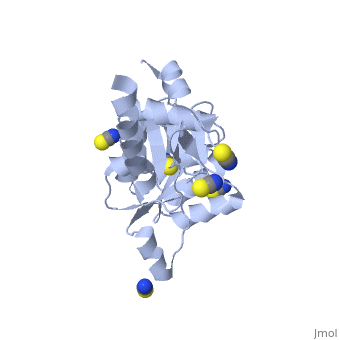Response regulator
From Proteopedia
(Difference between revisions)
| Line 1: | Line 1: | ||
<StructureSection load='1kgs' size='350' side='right' scene='' caption='Se-Met DNA-binding response regulator D complex with thiocyanate, [[1kgs]]'> | <StructureSection load='1kgs' size='350' side='right' scene='' caption='Se-Met DNA-binding response regulator D complex with thiocyanate, [[1kgs]]'> | ||
| - | |||
'''Response regulators''' (RR) are part of the two-component signal transduction systems which enable bacteria to sense and respond to a wide range of environments. | '''Response regulators''' (RR) are part of the two-component signal transduction systems which enable bacteria to sense and respond to a wide range of environments. | ||
Two-component RR is a complex of histidine kinase (sensor protein SP) and RR. The RR act as phosphorylation-activated switches. Most RR consist of N terminal which is the signal receiving domain and C terminal which is the DNA-binding domain (DBD). | Two-component RR is a complex of histidine kinase (sensor protein SP) and RR. The RR act as phosphorylation-activated switches. Most RR consist of N terminal which is the signal receiving domain and C terminal which is the DNA-binding domain (DBD). | ||
| Line 198: | Line 197: | ||
**[[4ml3]], [[4mld]] – SpRR Rec domain (mutant)<br /> | **[[4ml3]], [[4mld]] – SpRR Rec domain (mutant)<br /> | ||
**[[4cbv]] – SpRR (mutant)<br /> | **[[4cbv]] – SpRR (mutant)<br /> | ||
| - | **[[2a9o]], [[2a9p]], [[ | + | **[[2a9o]], [[2a9p]], [[6ebb]] – SpRR + Mn + BeF3<br /> |
**[[4zms]] ,[[4zmr]] - SpRR + Mg + BeF3<br /> | **[[4zms]] ,[[4zmr]] - SpRR + Mg + BeF3<br /> | ||
**[[2pln]] – HP1043 – ''Helicobacter pylori''<br /> | **[[2pln]] – HP1043 – ''Helicobacter pylori''<br /> | ||
Revision as of 07:20, 15 August 2019
| |||||||||||
3D Structures of response regulator
Updated on 15-August-2019
References
- ↑ Smith JG, Latiolais JA, Guanga GP, Citineni S, Silversmith RE, Bourret RB. Investigation of the role of electrostatic charge in activation of the Escherichia coli response regulator CheY. J Bacteriol. 2003 Nov;185(21):6385-91. PMID:14563873
- ↑ Ladds JC, Muchova K, Blaskovic D, Lewis RJ, Brannigan JA, Wilkinson AJ, Barak I. The response regulator Spo0A from Bacillus subtilis is efficiently phosphorylated in Escherichia coli. FEMS Microbiol Lett. 2003 Jun 27;223(2):153-7. PMID:12829280
- ↑ Hecht GB, Newton A. Identification of a novel response regulator required for the swarmer-to-stalked-cell transition in Caulobacter crescentus. J Bacteriol. 1995 Nov;177(21):6223-9. PMID:7592388
- ↑ Menon S, Wang S. Structure of the Response Regulator PhoP from Mycobacterium tuberculosis Reveals a Dimer through the Receiver Domain. Biochemistry. 2011 Jul 5;50(26):5948-57. Epub 2011 Jun 13. PMID:21634789 doi:10.1021/bi2005575
- ↑ Eraso JM, Kaplan S. Complex regulatory activities associated with the histidine kinase PrrB in expression of photosynthesis genes in Rhodobacter sphaeroides 2.4.1. J Bacteriol. 1996 Dec;178(24):7037-46. PMID:8955382
- ↑ Malone JG, Williams R, Christen M, Jenal U, Spiers AJ, Rainey PB. The structure-function relationship of WspR, a Pseudomonas fluorescens response regulator with a GGDEF output domain. Microbiology. 2007 Apr;153(Pt 4):980-94. PMID:17379708 doi:http://dx.doi.org/10.1099/mic.0.2006/002824-0
- ↑ Allen JF. Redox control of transcription: sensors, response regulators, activators and repressors. FEBS Lett. 1993 Oct 18;332(3):203-7. PMID:8405457
Proteopedia Page Contributors and Editors (what is this?)
Michal Harel, Joel L. Sussman, Alexander Berchansky, Jaime Prilusky

